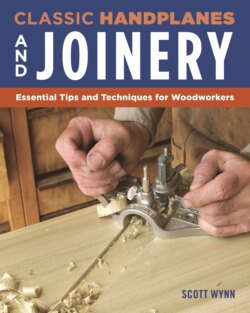Читать книгу Classic Handplanes and Joinery - Scott Wynn - Страница 11
На сайте Литреса книга снята с продажи.
Steel Grain
ОглавлениеThis standardized chart refers to the average grain size within a steel. The numbers range from 00 to 14, with 00 being the largest (about 1/50" [0.5mm]), and 14 the smallest (about 1/10000" [0.003mm]). Manufacturers normally use fine grain size 7 or finer for the steel used in tools.
| ASTM Grain Size ASTM grain size number (N) | Average diameter of grain (assumed) as sphere at 1 X (mm) |
| 00 | 0.51 |
| 0 | 0.36 |
| 1 | 0.25 |
| 2 | 0.18 |
| 3 | 0.125 |
| 4 | 0.090 |
| 5 | 0.065 |
| 6 | 0.045 |
| 7 | 0.032 |
| 8 | 0.022 |
| 9 | 0.016 |
| 10 | 0.011 |
| 11 | 0.008 |
| 12 | 0.006 |
| 13 | 0.004 |
| 14 | 0.003 |
From the article “Determining Austenite Grain Size of Steels: 4 Methods—Metallurgy” by Jayanti S., on www.engineeringnotes.com.
Grain is a function of the initial quality of the steel used, the alloys added, and how the steel is worked or formed. In addition to the average size of the crystals, the initial quality of the steel may include impurities, called inclusions, which may persist throughout refining. Inclusions add large irregularities to the grain. Irregularities sometimes are used to good effect in swords and perhaps axes, but except for the backing steel on laminated blades, impurities are a detriment to a plane blade. Impurities, when sharpened out to the edge, break off easily, causing chipping and rapid dulling of the edge. The dirtier the steel, the more rapidly it dulls. Fine chipping will not affect the performance of an edge used for chopping wood; depending on the inclusion, it can add tensile, shock-resisting strength to the blade. But for fine woodworking, such as planing a surface, even fine inclusions prevent sharpening the blade to its full potential and shorten the edge’s life.
Alloys change the texture of the grain. They may be part of the steel’s original composition (though usually in small amounts), or added in a recipe to increase the steel’s resistance to shock and heat. Alloys often coarsen the grain, so there is a trade-off. While the edge of an alloy blade may be more durable, especially under adverse working conditions, it may not sharpen as well as an unalloyed blade. To shear wood cleanly, no other attribute of an edge is more important than fineness.
